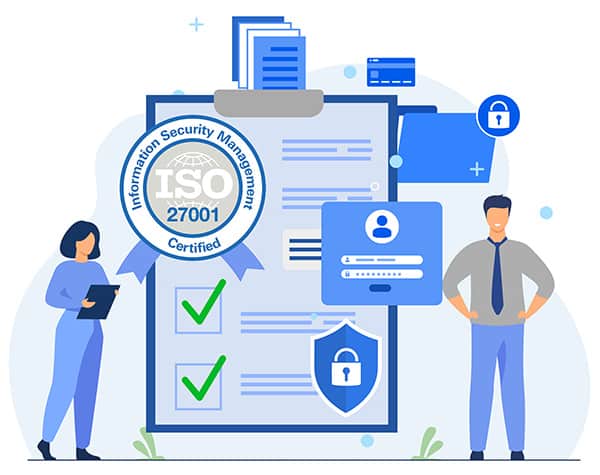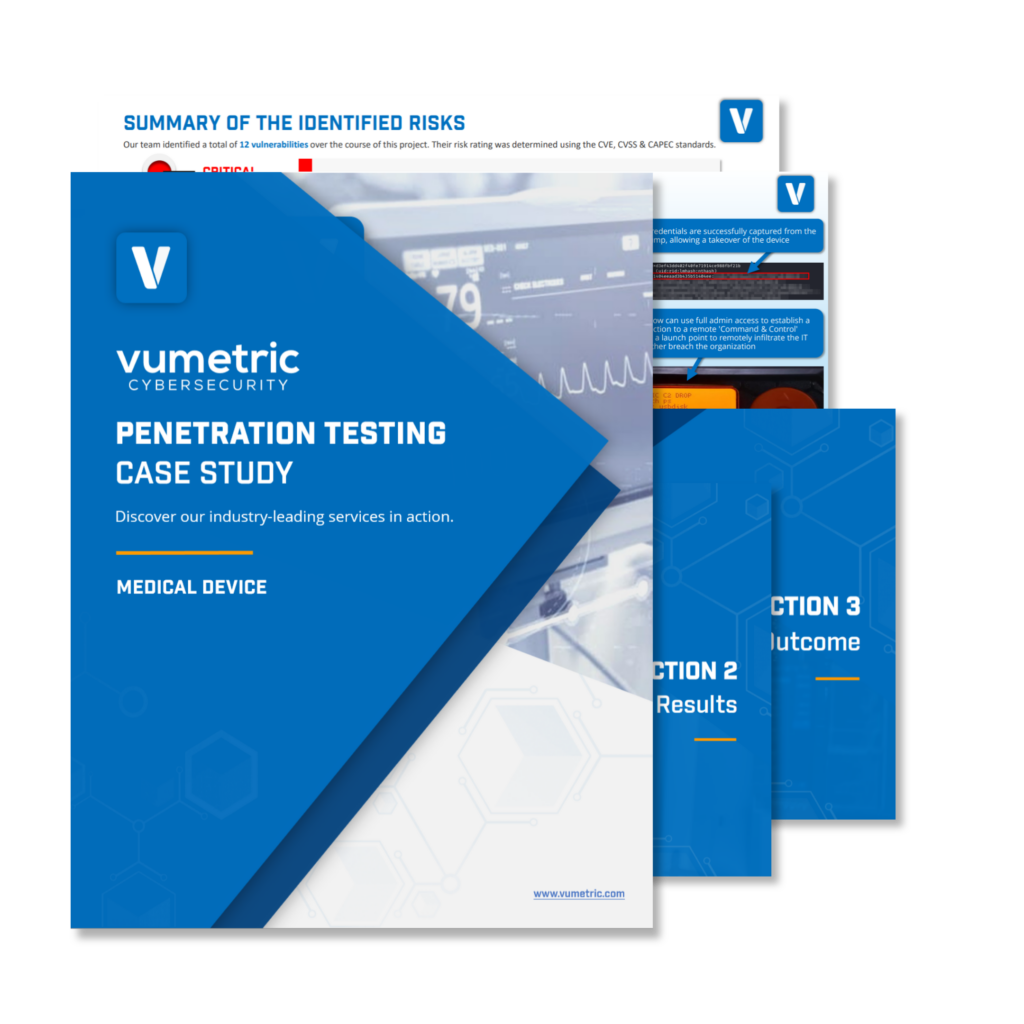SERVICES OVERVIEW
What is FDA Compliance Penetration Testing?
Penetration testing (or pentesting) for FDA Compliance is a comprehensive security assessment designed to help medical device manufacturers and healthcare organizations meet the cybersecurity requirements of the U.S. Food and Drug Administration (FDA). Our certified team simulates real-world cyber attacks to identify vulnerabilities in medical devices and underlying healthcare IT systems that could compromise sensitive data, disrupt operations, or jeopardize patient safety. By proactively addressing risks, organizations improve their cybersecurity posture and ensure compliance with FDA regulations as efficiently as possible.
Our rigorous testing methodology aligns with industry best practices and FDA guidance, including the Pre-Market and Post-Market Cybersecurity Guidelines. We provide detailed reports highlighting discovered vulnerabilities, along with prioritized recommendations for remediation. We provide organizations with the insights and actionable intelligence needed to strengthen their cybersecurity defenses, protect sensitive information, and ensure the safety and reliability of their products and services in the face of evolving cyber threats, all in accordance with the latest FDA requirements.
Why Should you Perform Penetration Testing For FDA Compliance?
- Navigating complex regulations
Complying with the various cybersecurity requirements outlined in FDA Pre-Market and Post-Market Guidance, such as security testing, threat modeling, risk management and documentation. - Protecting sensitive / proprietary data
Securing patient information, proprietary data, and intellectual property from unauthorized access or unintentional disclosure. - Ensuring safe integrations
Managing and securing a diverse and complex ecosystem of interconnected medical devices and systems. - Evolving cyber threat landscape
Adapting to and mitigating the risks posed by the continuously evolving cyber threat landscape targeting healthcare.

How Will a Penetration Test Help With FDA Compliance?
- Uncover hidden or unknown vulnerabilities
Identify security risks in medical devices or software and their underlying infrastructure that could be exploited by attackers. - Test and validate security controls
Assess the effectiveness of existing cybersecurity measures in mitigating modern threats or targeted hacking attempts. - Benchmark with FDA requirements and cybersecurity standards
Ensure proper implementation of FDA guidance and the latest security standards (MITRE, OSSTMM, OWASP, etc.). - Prioritize and document risk mitigation efforts
Gain insights into the most critical vulnerabilities to prioritize remediation activities, allocate resources effectively and easily demonstrate your security risk management and improvements.
What Will be Assessed During a FDA Compliance Penetration Test?
- Compliance with FDA guidance
Pre-Market and Post-Market Cybersecurity Guidelines, 21 CFR Part 11, 501(k), and more - Medical devices
Remote access protocols, encryption, update mechanisms, wireless communication, data transfer, patient care controls, etc. - Network infrastructure
Network configurations, firewall settings, communication protocols, access points, data transmission, etc. - Applications and software
Device software, SAMD, Web applications, APIs, mobile apps, cloud-based service, etc. - Authentication and access control
User account management, authentication mechanisms, password policies and disclosure, privilege escalation, etc. - And More
Legacy system integration, third-party components, backup and recovery systems, etc.

What are the Benefits of Conducting a Penetration Test For FDA Compliance?
Conducting penetration testing is an essential step of achieving and maintaining FDA compliance, but it also contributes to improving your security posture significantly.
Enhanced Patient Safety
Ensure the safety and reliability of devices or services used in patient care by preventing tampering of critical functions.
FDA Cybersecurity Compliance
Achieve and maintain compliance with the FDA's cybersecurity requirements.
Strategic Security Investment
Prioritize and strategically allocate resources towards your most critical risks and vulnerabilities.
Improved PHI Data Security
Secure sensitive patient data and intellectual property against unauthorized access and data breaches.
Minimized Interruptions of Service
Protect against potential disruptions or interruptions to critical healthcare services.
Increased Risk Visibility
Gain a deep understanding of your risks and inform stakeholders / third-parties on the state of your device's security.
Need Pricing For a FDA Compliance Penetration Test?
Answer a few questions regarding your organization’s pentesting needs to quickly receive a tailored quote. No engagement.
- You can also call us directly: 1-877-805-7475
FDA CYBERSECURITY GUIDELINES
The FDA’s Role in The Cybersecurity of Medical Devices and SAMD
The U.S. Food and Drug Administration regulates medical devices and works aggressively to reduce cybersecurity risks in what is a rapidly changing environment. The following medical device cybersecurity awareness video is provided by FDA’s medical device cybersecurity team:
The FDA's Premarket
Cybersecuirity Guidance
FDA’s Premarket Guidance provides recommendations for medical device manufacturers to address cybersecurity risks during the design and development of their products, prior to launching on the market.
- Perform a risk assessment to identify potential cybersecurity issues.
- Develop a risk management plan to mitigate identified risks.
- Provide documentation to support the measures implemented.
- Conduct regular penetration testing to uncover and address security vulnerabilities prior to market launch.


The FDA's Postmarket
Cybersecurity Guidance
FDA’s Postmarket Guidance provides recommendations for manufacturers to addess postmarket cybersecurity vulnerabilities for marketed and distributed medical devices
- Implement a robust cybersecurity risk management program.
- Monitor and detect cybersecurity vulnerabilities.
- Continuously monitor and detect potential cybersecurity vulnerabilities.
- Assess the risk of identified vulnerabilities & implement remediations.
- Communicate and collaborate with stakeholders for coordinated vulnerability disclosure.
- Provide regular updates and patches
FDA Compliance Penetration Testing FAQ
Couldn’t find the information you were looking for? Ask an expert directly.
Penetration testing helps address several key FDA guidelines and regulations related to medical device cybersecurity, including:
- FDA Pre-Market Guidance for Management of Cybersecurity in Medical Devices
- FDA Post-Market Management of Cybersecurity in Medical Devices
- FDA Content of Premarket Submissions for Management of Cybersecurity in Medical Devices
- FDA Postmarket Cybersecurity Programs for Medical Devices
- 21 CFR Part 820 Quality System Regulation
The frequency of penetration testing depends on various factors, such as the complexity of your systems, the sensitivity of the data processed, and the pace of technological changes. However, the FDA recommends performing penetration testing at least annually or whenever significant changes are made to your systems or products. Our experts can help you determine an appropriate and realistic testing frequency based on your specific needs and risk profile.
- Detailed vulnerability report highlighting discovered risks and their potential impact
- Prioritized remediation recommendations to guide your risk management efforts
- Executive summary for non-technical stakeholders and decision-makers
- Remediation validation and retesting to ensure the effectiveness of implemented security controls
- Compliance attestation upon successful completion of remediation activities
- Ongoing support and guidance to help you maintain a strong cybersecurity posture and FDA compliance
Our assessments adhere to industry-recognized standards and best practices, including NIST SP 800-115, OWASP Testing Guide, and FDA Pre-Market and Post-Market Cybersecurity Guidance. We are accredited to ISO/IEC 17025 and employ a team of skilled cybersecurity professionals who stay up-to-date on the latest threats and techniques to deliver thorough and effective testing services.
Yes, penetration testing is a crucial aspect of ensuring FDA compliance for Software as a Medical Device (SaMD). The FDA's guidance on "Cybersecurity Considerations for Software as a Medical Device" emphasizes the importance of secure design, development, and maintenance of SaMD throughout its lifecycle. Penetration testing can help identify vulnerabilities in SaMD applications, APIs, and associated infrastructure, enabling manufacturers to address these issues and maintain compliance with FDA cybersecurity expectations for SaMD.
Why Choose Vumetric for
FDA Compliance Penetration Testing?
Vumetric is an ISO9001-certified boutique provider entirely dedicated to cybersecurity testing. Our methodologies are proven and our understanding of cybersecurity risks is extensive, allowing us to provide clear advice to our clients that is pragmatic, adapted to their needs and efficient in securing against the latest security threats.
Proven
Methodologies
Our testing methodologies are based on industry best practices and standards.
ExperiencedTeam
Our team of certified experts conducts more than 400 pentest projects annually.
ActionableResults
We provide quality reports with actionable recommendations to fix identified vulnerabilities.
Read Our Clients' Success Stories
Discover how our pentest services helps countless organizations every year improve their cybersecurity and prevent cyberattacks:
“ They were professional, knowledgeable, and transparent throughout. Their presentation of findings was engaging and effective. Their report and recommendations were easy to understand. ”
Louis E., Director of IT & CISO
“ They offered multiple alternative solutions to suit our budget, allowing us to prioritize how we spent our money. They were able to identify more risks than we could think of, and proposed straightforward solutions for them. ”
William K., Compliance Manager
Featured Cybersecurity Resources
Gain insight on emerging hacking trends, recommended best practices and tips to improve your cybersecurity posture:







